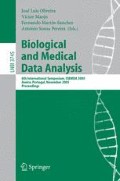Abstract
The use of sequence alignments for establishing protein homology relationships has an extensive tradition in the field of bioinformatics, and there is an increasing desire for more statistical methods in the data analysis. We present statistical methods and algorithms that are useful when the protein alignments can be divided into two or more populations based on known features or traits. The algorithms are considered valuable for discovering differences between populations at a molecular level. The approach is illustrated with examples from real biological data sets, and we present experimental results in applying our work on bacterial populations of Vibrio, where the populations are defined by optimal growth temperature, T opt .
Access this chapter
Tax calculation will be finalised at checkout
Purchases are for personal use only
Preview
Unable to display preview. Download preview PDF.
References
Russell, N.J.: Toward a molecular understanding of cold activity of enzymes from psychrophiles. Extremophiles 4, 83–90 (2000)
Karlin, S., Brocchieri, L., Trent, J., Blaisdell, B.E., Mrazek, J.: Heterogeneity of genome and proteome content in bacteria, archaea, and eukaryotes. Theor. Popul. Biol. 61, 367–390 (2002)
Pe’er, I., Felder, C.E., Man, O., Silman, I., Sussman, J.L., Beckmann, J.S.: Proteomic signatures: Amino acid and oligopeptide compositions differentiate among phyla. Proteins-Structure Function and Genetics 54(1), 20–40 (2004)
Saunders, N.F.W., Thomas, T., Curmi, P.M.G., et al.: Mechanisms of thermal adaptation revealed from the genomes of the Antarctic Archaea Methanogenium frigidum and Methanococcoides burtonii. Genome Res. 13(7), 1580–1588 (2003)
Nikolova, N., Jaworska, J.: Approaches to measure chemical similarity - A review. QSAR & Combinatorial Science 9-10, 1006–1026 (2004)
Kearsley, S.K., Sallamack, S., Fluder, E.M., Andose, J.D., Mosley, R.T., Sheridan, R.P.: Chemical Similarity Using Physicochemical Property Descriptors. J. Chem. Inf. Comput. Sci. 36, 118–127 (1996)
Basak, S.C., Grunwald, G.D.: Molecular Similarity And Estimation of Molecular- Properties. J. Chem. Inf. Comput. Sci. 35, 366–372 (1995)
Dayhoff, M.O., Schwartz, R.M., Orcutt, B.C.: A model of evolutionary change in proteins. Atlas of Protein Sequences and Structure 5 (suppl. 3), 345–352 (1978)
Benner, S.A., Cohen, M.A., Gonnet, G.H.: Amino acid substitution during functionally constrained divergent evolution of protein sequences. Protein Eng. 7(11), 1323–1332 (1994)
Jones, D.T., Taylor, W.R., Thornton, J.M.: The rapid generation of mutation data matrices from protein sequences. Computer Applications in the Biosciences 8(3), 275–282 (1992)
Agresti, A.: Exact inference for categorical data: recent advances and continuing controversies. Statistics in Medicine 20(17-18), 2709–2722 (2001)
Agresti, A.: Categorical Data Analysis, 2nd edn. John Wiley & Sons, Chichester (2002)
Kang, S.H., Kim, S.J.: A comparison of the three conditional exact tests in two-way contingency tables using the unconditional exact power. Biometrical Journal 46(3), 320–330 (2004)
Conover, W.J.: Practical Nonparametric Statistics, 3rd edn. John Wiley & Sons, Chichester (1999)
Oppenheim, A.V., Schafer, R.W.: Discrete-Time Signal Processing, 2nd edn. Prentice-Hall, Englewood Cliffs (1999)
Benjamini, Y., Hochberg, Y.: Controlling the false discovery rate: a practical and powerful approach to multiple testing. Journal of the Royal Statistical Society, Series B 57, 289–300 (1995)
Benjamini, Y., Yekutieli, D., Ruepp, A., Frickey, T., et al.: The control of the false discovery rate in multiple testing under dependency. Ann. Stat. 29(4), 1165–1188 (2001)
Kawashima, S., Ogata, H., Kanehisa, M.: A Aindex: amino acid index database. Nucleic Acids Res. 27, 368–369 (1999)
Gromiha, M.M., Oobatake, M., Sarai, A.: Important amino acid properties for enhanced thermostability from mesophilic to thermophilic proteins. Biophysical Chemsitry 82, 51–67 (1999)
Tang, H., Wyckoff, G.J., Lu, J., Wu, C.-I.: A Universal Evolutionary Index for Amino Acid Changes. Mol. Biol. Evol. 21, 1548–1556 (2004)
Author information
Authors and Affiliations
Editor information
Editors and Affiliations
Rights and permissions
Copyright information
© 2005 Springer-Verlag Berlin Heidelberg
About this paper
Cite this paper
Thorvaldsen, S., Flå, T., Willassen, N.P. (2005). Extracting Molecular Diversity Between Populations Through Sequence Alignments. In: Oliveira, J.L., Maojo, V., Martín-Sánchez, F., Pereira, A.S. (eds) Biological and Medical Data Analysis. ISBMDA 2005. Lecture Notes in Computer Science(), vol 3745. Springer, Berlin, Heidelberg. https://doi.org/10.1007/11573067_32
Download citation
DOI: https://doi.org/10.1007/11573067_32
Publisher Name: Springer, Berlin, Heidelberg
Print ISBN: 978-3-540-29674-4
Online ISBN: 978-3-540-31658-9
eBook Packages: Computer ScienceComputer Science (R0)

